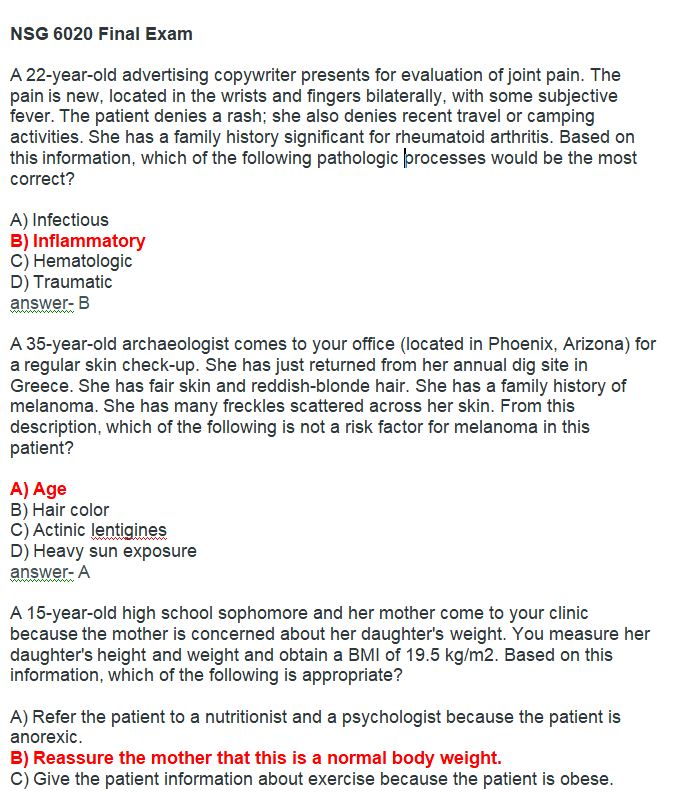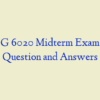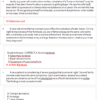Description
NSG 6020 Final Exam – Question and Answers- South University
- A 22-year-old advertising copywriter presents for evaluation of joint pain. The pain is new, located in the wrists and fingers bilaterally, with some subjective fever. The patient denies a rash; she also denies recent travel or camping activities. She has a family history significant for rheumatoid arthritis. Based on this information, which of the following pathologic processes would be the most correct?
- A 35-year-old archaeologist comes to your office (located in Phoenix, Arizona) for a regular skin check-up. She has just returned from her annual dig site in Greece. She has fair skin and reddish-blonde hair. She-has a family history of melanoma. She has many freckles scattered across her skin. From this description, which of the following is not a risk factor for melanoma in this patient?
- A 15-year-old high school sophomore and her mother come to your clinic because the mother is concerned about her daughter’s weight. You measure her daughter’s height and weight and obtain a BMI of 19.5 kg/m2. Based on this information, which of the following is appropriate?
- A middle-aged man comes in because he has noticed multiple small, blood-red, raised lesions over his anterior chest and abdomen for the past several months. They are not painful and he has not noted any bleeding or bruising. He is concerned this may be consistent with a dangerous condition. What should you do?
- Jacob, a 33-year-old construction worker, complains of a “lump on his back” over his scapula. It has been there for about a year and is getting larger. He says his wife has been able to squeeze out a cheesy-textured substance on occasion. He worries this may be cancer. When gently pinched from the side, a prominent dimple forms in the middle of the mass. What is most likely?
- A patient comes to you for the appearance of red patches on his forearms that have been present for several months. They remain for several weeks. He denies a history of trauma. Which of the following is likely?
- A 19-year old-college student presents to the emergency room with fever, headache, and neck pain/stiffness. She is concerned about the possibility of meningococcal meningitis. Several of her dorm mates have been vaccinated, but she hasn’t been. Which of the following physical examination descriptions is most consistent with meningitis?
- A 58-year-old gardener comes to your office for evaluation of a new lesion on her upper chest. The lesion appears to be “stuck on” and is oval, brown, and slightly elevated with a flat surface. It has a rough, wartlike texture on palpation. Based on this description, what is your most likely diagnosis?
- A patient presents for evaluation of a cough. Which of the following anatomic regions can be responsible for a cough?
- A 72-year-old retired truck driver comes to the clinic with his wife for evaluation of hearing loss. He has noticed some decreased ability to hear what his wife and grandchildren are saying to him. He-admits to lip-reading more. He has a history of noise exposure in his young adult years: He worked as a sound engineer at a local arena and had to attend a lot of concerts. Based on this information, what is the most likely finding regarding his hearing acuity?
- Mrs. Anderson presents with an itchy rash which is raised and appears and disappears in various locations. Each lesion lasts for many minutes. What most likely accounts for this rash?
- A new mother is concerned that her child occasionally “turns blue.” On further questioning, she mentions that this is at her hands and feet. She does not remember the child’s lips turning blue. She is otherwise eating and growing well. What would you do now?
- An 89-year-old retired school principal comes for an annual check-up. She would like to know whether or not she should undergo a screening colonoscopy. She has never done this before. Which of the following factors should not be considered when discussing whether she should go for this screening test?
- You are speaking to an 8th grade class about health prevention and are preparing to discuss the ABCDEs of melanoma. Which of the following descriptions correctly defines the ABCDEs?
- A 79-year-old retired banker comes to your office for evaluation of difficulty with urination; he gets up five to six times per night to urinate and has to go at least that often in the daytime. He does not feel as if his bladder empties completely; the strength of the urinary stream is diminished. He denies dysuria or hematuria. This problem has been present for several years but has worsened over the last 8 months. You palpate his prostate. What is your expected physical examination finding, based on this description?
- A young man comes to you with an extremely pruritic rash over his knees and elbows which has come and gone for several years. It seems to be worse in the winter and improves with some sun exposure. On examination, you notice scabbing and crusting with some silvery scale, and you are observant enough to notice small “pits” in his nails. What would account for these findings?
- A 15-year-old high school sophomore comes to the clinic for evaluation of a 3-week history of sneezing; itchy, watery eyes; clear nasal discharge; ear pain; and nonproductive cough. Which is the most likely pathologic process?
- A 68-year-old retired farmer comes to your office for evaluation of a skin lesion. On the right temporal area of the forehead, you see a flattened papule the same color as his skin, covered by a dry scale that is round and feels hard. He has several more of these scattered on the forehead, arms, and legs. Based on this description, what is your most likely diagnosis?
- An 8-year-old girl comes with her mother for evaluation of hair loss. She denies pulling or twisting her hair, and her mother has not noted this behavior at all. She does not put her hair in braids. nsg 6020 final exam On physical examination, you note a clearly demarcated, round patch of hair loss without visible scaling or inflammation. There are no hair shafts visible. Based on this description, what is your most likely diagnosis?
- A 19-year-old construction worker presents for evaluation of a rash. He notes that it started on his back with a multitude of spots and is also on his arms, chest, and neck. It itches a lot. He does sweat more than before because being outdoors is part of his job. On physical examination, you note dark tan patches with a reddish cast that has sharp borders and fine scales, scattered more prominently around the upper back, chest, neck, and upper arms as well as under the arms. Based on this description, what is your most likely diagnosis?
- Which of the following booster immunizations is recommended in the older adult population?
- A patient presents for evaluation of a sharp, aching chest pain which increases with breathing. Which anatomic area would you localize the symptom to?
- Ms. Whiting is a 68 year old who comes in for her usual follow-up visit. You notice a few flat red and purple lesions, about 6 centimeters in diameter, on the ulnar aspect of her forearms but nowhere else. She doesn’t mention them. They are tender when you examine them. What should you do?
- You have recently returned from a medical missions trip to sub-Saharan Africa, where you learned a great deal about malaria. You-decide to use some of the same questions and maneuvers in your “routine” when examining patients in the midwestern United States. You are disappointed to find that despite getting some positive answers and findings, on further workup, none of your patients has malaria except one, who recently emigrated from Ghana. How should you next approach these questions and maneuvers? nsg 6020 final exam
On routine screening you notice that the cup-to-disc ratio of the patient’s right eye is 1:2. What ocular condition should you suspect? nsg 6020 final exam- Mrs. Hill is a 28-year-old African-American with a history of SLE (systemic lupus erythematosus). She has noticed a raised, dark red rash on her legs. When you press on the rash, it doesn’t blanch. What would you tell her regarding her rash?
- A 47-year-old contractor presents for evaluation of neck pain, which has been intermittent for several years. He normally takes over-the-counter medications to ease the pain, but this time they haven’t worked as well and he still has discomfort. He recently wallpapered the entire second floor in his house, which caused him great discomfort. The pain resolved with rest. He denies fever, chills, rash, upper respiratory symptoms, trauma, or injury to the neck. Based on this description, what is the most likely pathologic process?
- A 28-year-old patient comes to the office for evaluation of a rash. At first there was only one large patch, but then more lesions erupted suddenly on the back and torso; the lesions itch. On physical examination, you note that the pattern of eruption is like a Christmas tree and that there are a variety of erythematous papules and macules on the cleavage lines of the back. Based on this description, what is the most likely diagnosis?
- Which of the following changes are expected in vision as part of the normal aging process?
- You are examining an unconscious patient from another region and notice Beau’s lines, a transverse groove across all of her nails, about 1 cm from the proximal nail fold. What would you do next?







